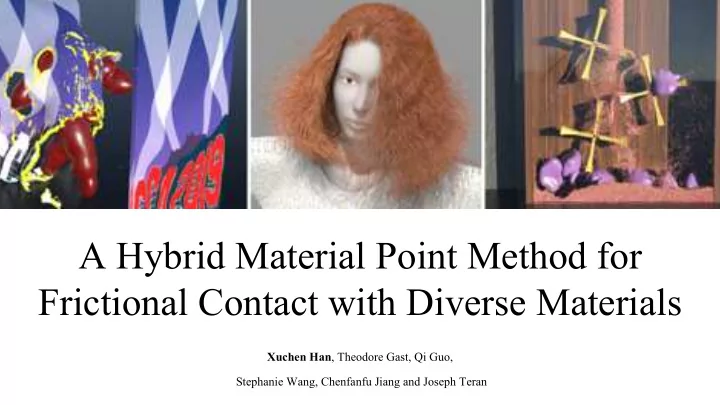

A Hybrid Material Point Method for Frictional Contact with Diverse Materials Xuchen Han , Theodore Gast, Qi Guo, Stephanie Wang, Chenfanfu Jiang and Joseph Teran
MPM is hybrid Lagrangian/Eulerian • Particles: constitutive modeling - the physics • Transfer: quadrature rule, collision detect, topology change • Grid handles: the Galerkin DOFs, BC, discretization
Stomakhin et al. 2013 Ram et al. 2015 Yue et al. 2015 Gast et al. 2015 Klar et al. 2016 Daviet et al. 2016 Stomakhin et al. 2015 Gao et al. 2018 Pradhana et al. 2018 Wolper et al. 2019
MPM for meshed objects Elastic potential Element wise energy density Deformation gradient Grid node force Grid node position Particle position
Jiang et al. 2017 Jiang et al. 2017 Guo et al. 2018 Guo et al. 2018
Drawbacks of MPM Δ" Grid = Δ" Mesh Δ" Grid = 0.1Δ" Mesh Δ" Grid = 0.01Δ" Mesh Numerical Friction Grid Dependency
MPM Collision Prevention • Type I: Collision modes penalized via potential energy • Type II: Smooth interpolation
Type I Collision Resolution
Traction in a continuum
Traction in a continuum + Cauchy stress -
Friction and plasticity Traction Normal force Frictional force Coulomb friction
Friction and plasticity Yield surface
MPM Our method
Our method MPM
MPM Collision Prevention • Type I: Collision modes penalized via potential energy • Move the DOFs to the Lagrangian Mesh
MPM Collision Prevention • Type I: Collision modes penalized via potential energy • Type II: Smooth interpolation
Type II Collision Resolution
MPM Collision Prevention • Type I: Collision modes penalized via potential energy Modify • Type II: Smooth interpolation
Hybrid MPM DOF ⋆ − / 1 Quadrature / 0 = / 1 45 / 0 ⋅ / 1 < 0: / 1 ⋆ / 1 / ? = / 0 − / 0 ⋅ : 1 : 1 Δ/ 1 = 9 1 : 1 + ;4= ∥ / ? ∥, −A 9 1 / ? : 1 / 0 ; 1 ; 1 ∥ / ? ∥ ˜ CDE − / B ∗ = ∑ Δ/ B = / B H B1 Δ/ 1 1 H B1 ; 1 ˜ H B1 = ∑ 0 H B0 ; 0
Hybrid MPM • 1) Lagrangian Update • 2) Transfer to grid • 3) Transfer to collision particles • 4) Apply impulses • 5) Update positions
Type II Collision Resolution
Modify Type II Collision
Modify Type II Collision Δ" Grid = Δ" Mesh Δ" Grid = 0.1Δ" Mesh Δ" Grid = 0.01Δ" Mesh MPM Our Method
Coupling with granular Material MPM (186s/frame) Our Method (66s/frame)
220s/frame 73s/frame
Strands Surface Curve
Strands Jiang et al. (2017) Our Method
Strands: Method (Continuous) • Decompose motion into J = J K ∘ J M • O = O K O M and O K = O K,P O K,Q • Strand energy: Ψ = Ψ M (O K,P ) + Ψ UPV (O M ) • Ψ UPV (O M ) consists of stretching, twisting, and bending potentials, see [Bergou et al. 2010] • Ψ M (O K,P ) is the St.Venant-Kirchhoff Hencky energy, chosen for the ease of plasticity return mapping
Strands: Method (Discrete) • Strand energy: Ψ = Ψ M (O K,P ) + Ψ UPV (O M ) UPV C + ΔW X B ∗ = / B / B • Ψ UPV (O M ) Lagrangian ; B • Ψ M (O K,P ) MPM Type to enter a caption. • Clean up with geometric collision algorithm Similar to Bridson et al. [2002]
Strands Comparison McAdams et al. (2009) Our Method More than 500 thousand missed collisions 120 missed collisions 156 seconds/frame 55 seconds/frame
Results
Results
Results
Results
Results
Results
Recommend
More recommend